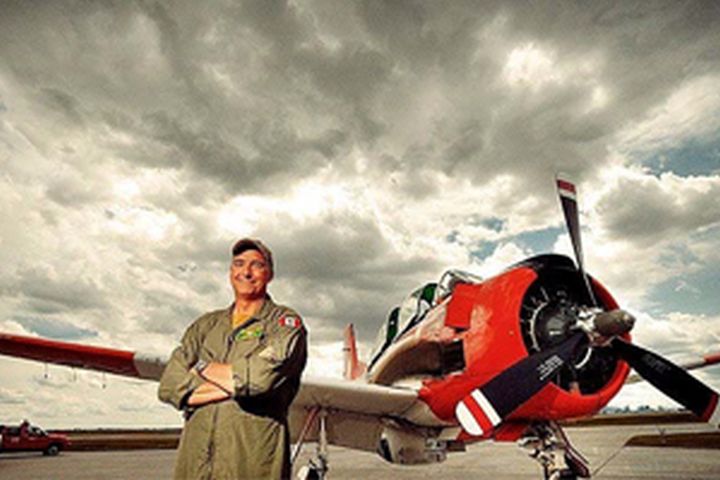A report into a fatal plane crash at an air show in Cold Lake, Alta. did not identify any glaring problems which may have caused the accident, saying mechanical issues and weather were not factors.

Pilot and geologist Bruce Evans of Calgary, died July 17, 2016, when his vintage Trojan T-28 aircraft crashed during an aerobatic routine in front of thousands of horrified spectators at CFB Cold Lake.
A report from the Transportation Safety Board of Canada (TSB) said Evans was an experienced pilot of over 20 years with over 4,043 flying hours – 461.5 of which were logged while flying the Trojan T-28. The TSB said he earned a private pilot’s licence in 1993, a commercial licence in 1995 and an airline transport licence in 2015.
Although the Cold Lake Airshow was the pilot’s first event of the season, he had performed in four air shows in Alberta and B.C. in 2015 without any problems, the report said.
He practiced for the show twice in the months leading up to the air show and his medical certificate was current.
READ MORE: ‘He just nosedived straight down’: witness to deadly plane crash at Alberta air show
On July 16 — the first day of the show — Evans performed his 15-move, 12-minute-long aerobatic routine without incident. On the second day, he took off and began performing the routine as planned.
About halfway through his performance Evans modified the order of his manoeuvres, flying what appeared to be half of a lazy eight followed by a half reverse Cuban, instead of the planned slow roll.The TSB noted it is not unusual for pilots to change the order, and is acceptable as long as the changes are consistent with those in the original plan.

Get daily National news
After the changes, the plane went into a roll. “As the aircraft reached the inverted position, the roll stopped and the nose began to pitch toward the ground,” the TSB report said.
The plane fell 500 feet, crashing into the ground at a high velocity in a near-vertical attitude. It was destroyed by the impact. The plane crashed near the radar station and some buildings. No one else was injured.
Firefighters arrived at the site within a minute and a half of the crash. The remainder of the show was cancelled.
The Trojan T-28 aircraft was built in 1954 and was originally used to train United States Navy pilots in the 1950s and ’60s. It was designed for the type of aerobatics in Evan’s routine, including barrel rolls and spins. He had owned the plane since 2007.
“An annual inspection was completed on April 9, 2016. No outstanding defects were noted in the maintenance or aircraft logbooks, and the aircraft had been operated within its weight-and-balance and design limits,” the TSB report stated.
The TSB determined the engine and flight controls had been operating normally prior to crash. It was a clear, 22 C day with very little wind. The TSB said weather conditions were not considered a factor in the crash.
Air shows in Canada must undergo an extensive approval process with Transport Canada, and the TSB said the Cold Lake show met all requirements. A Transport Canada inspector is required to attend at least one day of the show to ensure rules are followed. The inspector for this show was not there on the second day when Evans died.

Evans grew up in a Canadian Air Force family. His biography on the Cold Lake Air Show’s website at the time said his father was an aircraft maintenance engineer.
It also said Evans was from Calgary and ran his own aerial geophysical survey company, Firefly Airborne Surveys, which combined his training as a professional geologist and passion for aviation.
READ MORE: Pilot in Alberta airshow crash remembered as humble and happy
Evans loved to share his passion for aviation with young people, said a friend who met him while they were both part of a training program teaching youth about Canada’s aviation history.
— With files from The Canadian Press











Comments